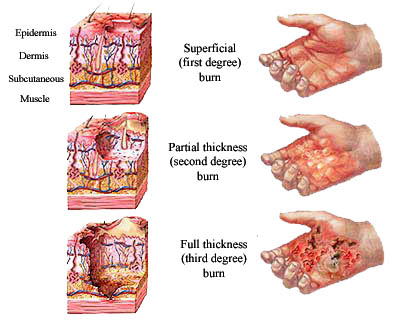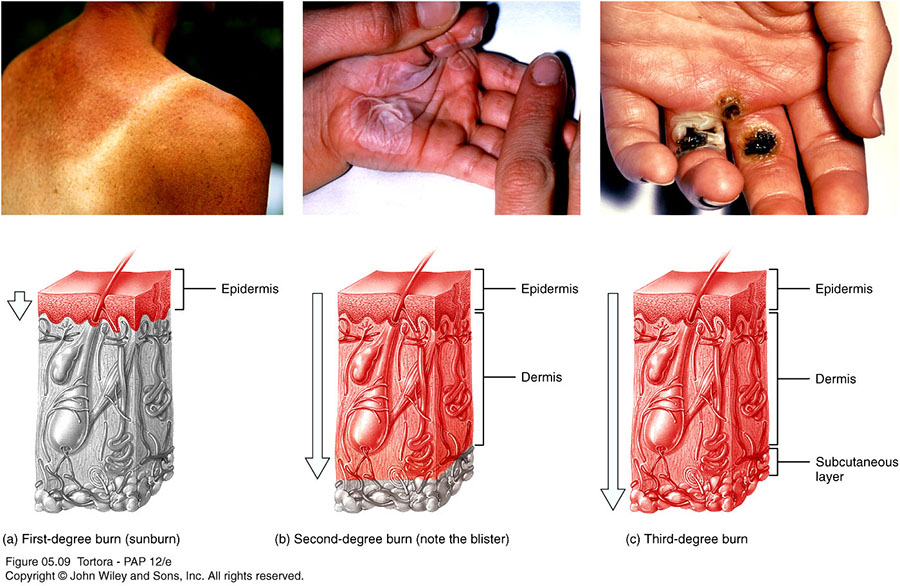A Burn Affecting Only the Epidermis Is a
Mild sunburn is an example. Sunburn is a good example of a first-degree type burn.

Different Types Of Burn Injuries Types Of Burns Burn Injury Dry Peeling Skin
A partial thickness burn involves the epidermis and dermis.

. A burn is an injury to the tissue of the body typically the skin. A burn effecting only the epidermis is a superficial partial-thickness burn which. A burn affecting only the epidermis is a A.
The burn site is red painful dry and with no blisters. More severe burns on the other hand tend to. Affects only the epidermis the outer layer of the skin causing redness and pain.
Second-degree burns involve the epidermis and part of the lower layer of skin the dermis. It effect epidermis and dermis along with the underlying struct. Asked Mar 16 2020 in Health Biomechanics by UCLABear.
A mild burn wound that only affects the epidermis is classified as a first-degree burn. A mild sunburn is an example of a first-degree burn. These burns affect only the outer layer of skin the epidermis and are sometimes called superficial burns These burns are usually mild and require the least amount of treatment.
First-degree burns affect only the epidermis or outer layer of skin. View the full answer. Fat is lost from the subcutaneous layer and the dermis shrinks.
A burn affecting only the epidermis is a. Additionally how does second degree burn affect the skin. First-degree burns do not blister.
The burn site is painful and it appears red and dry without blisters. Epidermis only 2nd degree. A burn that involves the epidermis only is called a deep partial-thickness burn.
This is important in that the epidermis helps regulate temperature and protects the body from infection. Skin wrinkles with age because. A second-degree burn affects the epidermis and parts of the dermis.
In treating a burn patient the rule of nines is used to estimate the. Mild sunburn is an example. Long-term tissue damage is rare and usually involves an increase or decrease in the skin color.
Surface area of the burn. First-degree burns affect only the top layer of skin the epidermis. A burn affecting only the epidermis is a Asuperficial partial-thickness burn.
First-degree burns are the most common type of burn and are the most likely type to occur from minor injuries like a sunburn or scalding yourself on hot water or steam. Second-degree partial thickness burns. Second-degree burns penetrate the epidermis and extend into the next layer of skin the dermis.
Question 5 First degree First degree burns - it affects only epidermis Second degree burns - both epidermis and dermis are affected Third degree burns - also called full thickness burns. But if the burn reaches the deeper reticular layer but doesnt extend through the entire layer then its considered a. A burn affecting only the epidermis is a N Multiple Choice superficial partial thickness burn second-degree burn deep partial-thickness burn third-degree burn The rotator cuff of the shoulder is composed mainly of Multiple Choice muscle tendons.
View the full answer. First-degree burns affect only the outer layer of skin the epidermis. The burn site is red painful dry and with no blisters.
Doctors categorize burns by their severity or degree. A burn that involves only the epidermis has symptoms of redness pain and slight swelling and can heal in about seven days without scarring is known as a ____. These minor burns are usually painful and appear red with some minor swelling.
Doctors define first degree burns as superficial burns because they only affect the top layer of the skin which is called the epidermis. A burn that invovles the epidermis only is called a deep partial-thickness burn. Affects the epidermis and dermis inner layer of the two main layers of skin and includes signs of redness swelling blisters and blotches.
The types of burns are. Mild sunburn is an example. A superficial burn also called a first-degree burn is a mild burn that affects only the outer layer of skin also known as the epidermis.
Part of dermis sometimes called a partial thickness burn 3rd degree. If only the papillary layer is burned its considered a second-degree superficial partial thickness burn. Superficial partial - thickness burn.
In second-degree burns the burn affects the epidermis and the dermis. Second-degree partial thickness burns Second-degree burns involve the epidermis and part of the dermis layer of skin. Burns are categorized as 1st 2nd or 3rd degree.
If there are blisters present it is likely a second-degree burn in which case you should seek medical attention. Superficial or first-degree burns only affect the epidermis the outermost layer of skin and typically the epidermis remains intact. The burn site is red painful dry and with no blisters.
Long-term tissue damage is rare and often consists of an increase or decrease in the skin color. First-degree burns affect only the epidermis or outer layer of skin. So in first-degree burns also called superficial burns the burn only affects the epidermis.
Long-term tissue damage is rare and usually consists of an increase or decrease in the skin color. Second-degree burns involve the epidermis and part of the dermis layer of skin. A burn which damages the epidermis only is classified as a bum second degree third.
A burn affecting only the epidermis is a Multiple Choice Athird-degree burn. These burns usually are quite mild though they may hurt a lot. FALSE Aging affects the appearance of the skin producing wrinkles and sagging due to decreased collagen and elastin formation.


No comments for "A Burn Affecting Only the Epidermis Is a"
Post a Comment